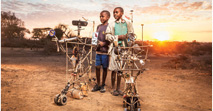2015 SUSTAINABILITY REPORT
Innovation
As a technology-based company, if we are not constantly innovating, we are, effectively, stagnating and losing ground. Many of our customers are quick to embrace new developments, becoming ever more sophisticated and demanding, and each generation expects to accomplish more. If we do not keep up with customer sophistication, we run the risk of losing market share and revenue. As a result, innovation is central to achieving our strategic objectives, retaining our competitive edge and ensuring that we continue to grow. Innovation allows us to transform the lives of all types of customers, nonetheless, by developing tailored and transformational products and services to meet all kinds of needs.
OUR FOUR DIFFERENT TYPES OF INNOVATION
financial services to the unbanked)
LOOKING AHEAD
From an innovation perspective, the focus next year will be on further developing and maximising the potential of our current strategies. Overall, the goal will be to expand our innovation pipeline, increasing the number of new ideas we generate and receive, as well as improving the quality and success rate of the ideas. We intend to bolster our ongoing initiatives, such as the popular AppStar and AppWizz challenges, with several new awareness campaigns in the coming year. Among these will be roadshows targeted at innovation hubs like universities and incubation centres. Safaricom also intends to make investments in Kenyan Start-ups through the Safaricom Spark Fund. In terms of growing mobile data customers and usage, we will continue with similar successful strategies, including promoting 3G- and 4G-enabled devices, running an Instagram Bundle campaign and exploring partnerships with local and international content providers. We also intend to exploit the growth of our fibre networks by commercialising the Safaricom Home Broadband proposition ‘The Big Box’. Similarly, from an M-PESA perspective, the focus will be to continue to drive the growth of Lipa na M-PESA and M-Shwari services, while exploring other ways of leveraging the new G2 M-PESA platform.
The challenge still remains understanding our customer needs and responding to their needs with relevant solutions to match their requirements, as opposed to flooding the market with untargeted products that are commercially driven and not focused on specific customer needs.




















